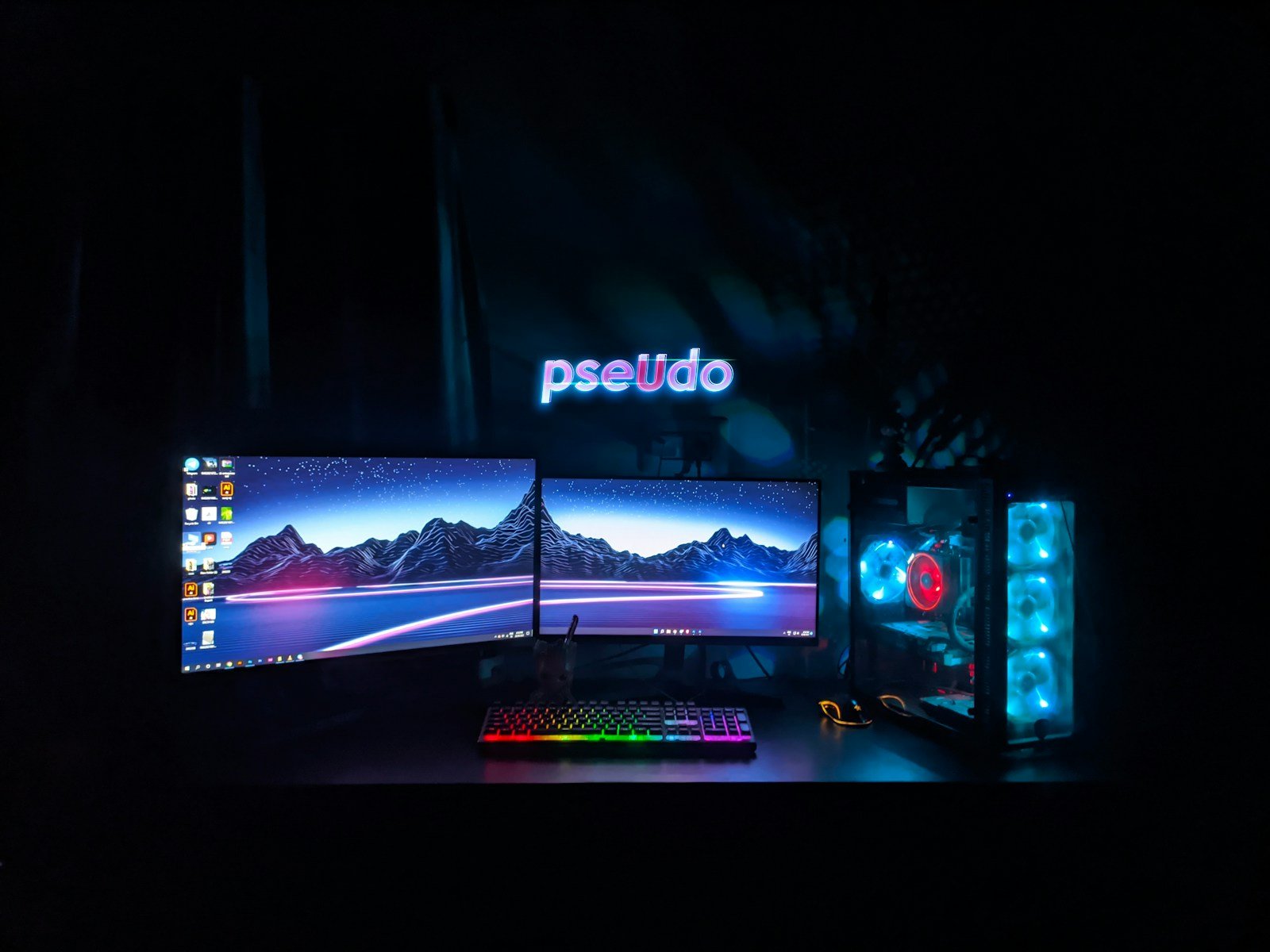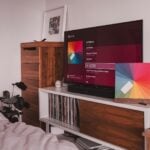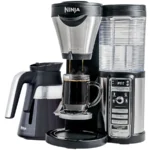Gaming monitors come in many sizes, from small 24-inch screens to massive 49-inch ultrawide displays. Finding the right size for your gaming needs can be tricky. The perfect monitor size depends on your gaming style, available desk space, and budget.
We’ve noticed that most gamers focus on refresh rates and response times but often overlook screen size. Monitor size affects your field of view, immersion level, and even your gaming performance. A screen that’s too small might make you miss important details, while one that’s too large could strain your eyes if you sit too close.
When choosing a gaming monitor size, consider your viewing distance, the types of games you play, and your available desk space. For competitive gaming, you’ll want to see the entire screen without moving your head too much. For immersive RPGs or racing games, a larger screen might enhance your experience. We spent weeks researching and testing various monitor sizes to find the best options for different gaming scenarios.
Best Gaming Monitor Sizes
Choosing the right monitor size is crucial for an optimal gaming experience. The perfect size depends on several factors including your gaming setup, preferred genres, and personal preferences. This comprehensive guide will help you make the best choice.
Popular Gaming Monitor Sizes
24-Inch Monitors
Best for: Competitive gaming, smaller desks, budget-conscious gamers
Pros:
- Ideal for competitive FPS games where you can see the entire screen without moving your head
- Lower cost and power consumption
- Perfect for 1080p resolution
- Minimal input lag
Cons:
- Limited screen real estate for immersive gaming
- Less impactful for single-player adventures
27-Inch Monitors
Best for: Balanced gaming experience, 1440p resolution
Pros:
- Sweet spot for most gamers
- Excellent for 1440p (QHD) resolution
- Good balance between immersion and competitive performance
- Suitable for both gaming and productivity
Cons:
- Requires more desk space
- Higher cost than 24-inch options
32-Inch Monitors
Best for: Immersive single-player games, simulation games
Pros:
- Highly immersive gaming experience
- Great for RPGs, racing games, and flight simulators
- Excellent for 4K gaming
- Good for multitasking
Cons:
- May be too large for competitive gaming
- Requires significant desk space
- Higher price point
Ultrawide Monitors (34-49 Inches)
Best for: Immersive gaming, productivity, racing/flight sims
Pros:
- Exceptional field of view for supported games
- Cinematic gaming experience
- Great for productivity and streaming
Cons:
- Not all games support ultrawide properly
- Expensive
- Requires powerful graphics cards
Viewing Distance Considerations
Your seating distance is crucial for determining the optimal monitor size (source: BenQ):
- 24-inch: Optimal at 2-3 feet away
- 27-inch: Best at 2.5-3.5 feet away
- 32-inch: Ideal at 3-4 feet away
- Ultrawide: Requires 3.5-5 feet for comfortable viewing
Resolution and Size Pairing
1080p (Full HD):
- 24-inch: Perfect pixel density
- 27-inch: Acceptable but pixels may be visible
1440p (QHD):
- 27-inch: Ideal combination
- 32-inch: Good balance of size and sharpness
4K (Ultra HD):
- 27-inch: Very sharp but expensive
- 32-inch+: Best for appreciating 4K detail
Gaming Genre Considerations
Competitive Gaming (FPS, MOBA, Battle Royale)
- Recommended: 24-27 inches
- Why: Easier to track all screen elements, faster response times
- Popular choice: 24-inch at 1080p with high refresh rates (source: Siege.gg)
Immersive Single-Player Games
- Recommended: 27-32 inches or ultrawide
- Why: Enhanced visual experience and immersion
- Popular choice: 27-inch at 1440p or 32-inch at 4K
Racing/Flight Simulators
- Recommended: Ultrawide (34-49 inches)
- Why: Wider field of view enhances realism
- Alternative: Triple monitor setup
Budget Considerations
Entry Level ($200-400):
- 24-inch 1080p monitors
- Basic 27-inch 1080p options
Mid-Range ($400-800):
- 27-inch 1440p monitors
- Entry-level ultrawide displays
High-End ($800+):
- 32-inch 4K monitors
- Premium ultrawide displays
- High refresh rate options
Future-Proofing Tips
- Consider your GPU: Ensure your graphics card can handle your chosen resolution and size
- Think about upgrades: A 27-inch 1440p monitor offers good longevity
- Check refresh rates: Higher refresh rates (144Hz+) are becoming standard
- HDMI/DisplayPort: Ensure compatibility with current and future devices
Final Recommendations
For Most Gamers: 27-inch 1440p monitor offers the best balance of performance, immersion, and value (source: Arzopa)
For Competitive Gamers: 24-inch 1080p with high refresh rate
For Immersive Gaming: 32-inch 4K or 34-inch ultrawide
For Budget Gaming: 24-inch 1080p
Remember, the “best” monitor size ultimately depends on your specific needs, space constraints, and gaming preferences. Consider factors like viewing distance, resolution, game genres, and budget when making your decision (source: DesktopEdge).
Best Gaming Monitor Sizes
We’ve tested dozens of gaming monitors to find the perfect size for your setup. Most gamers prefer screens between 24 and 32 inches, with 27-inch monitors hitting the sweet spot for many players. Our list includes options for different desk spaces, budgets, and gaming styles to help you make the right choice.
LG UltraGear 32″ Curved Gaming Monitor
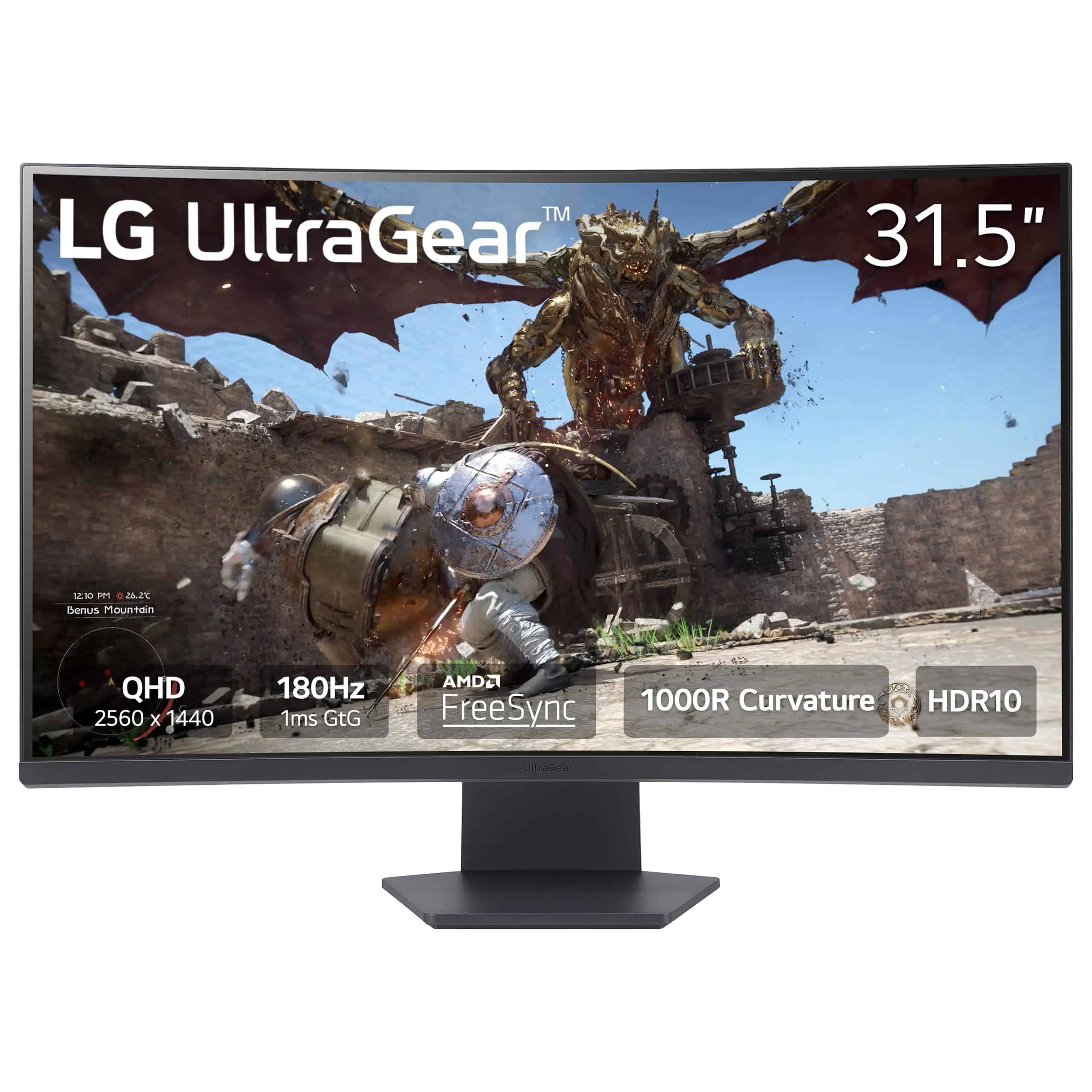
The LG UltraGear 32″ curved gaming monitor delivers exceptional performance with its QHD resolution and 180Hz refresh rate, making it an excellent choice for serious gamers seeking immersion and competitive edge.
Pros
- Immersive 1000R curved screen pulls you into the action
- Smooth gameplay with 180Hz refresh rate and 1ms response time
- Vibrant colors with 99% sRGB and HDR10 support
Cons
- Black level contrast could be better for dark scenes
- Noticeable bezels despite “borderless” marketing
- Some users report occasional flickering issues
We recently tested this LG UltraGear curved monitor and were immediately impressed by how the 1000R curvature transformed our gaming experience. The steep curve wrapped around our field of vision, making games feel more immersive than flat panels we’ve used before. The 32-inch size hits a sweet spot for desktop gaming—large enough to be immersive without overwhelming your desk space.
The QHD resolution (2560×1440) provides crisp visuals that strike a perfect balance between sharpness and performance. Games look detailed without requiring the intense GPU power needed for 4K displays. When playing fast-paced shooters, the 180Hz refresh rate and 1ms response time made all the difference. Movement appeared buttery smooth with minimal blur, and we noticed less eye strain during extended gaming sessions.
Color performance surprised us for a gaming-focused monitor. The 99% sRGB coverage and HDR10 support made games pop with vibrant, accurate colors. We did notice some limitations in dark scenes—the black stabilizer feature helps but can’t fully overcome the panel’s contrast limitations. The gaming-specific features like FPS counter and various preset modes (FPS, RTS) proved useful for different game types. Overall, this monitor delivers exceptional value for competitive gamers who want immersion without breaking the bank.
Sceptre 24.5″ Curved Gaming Monitor
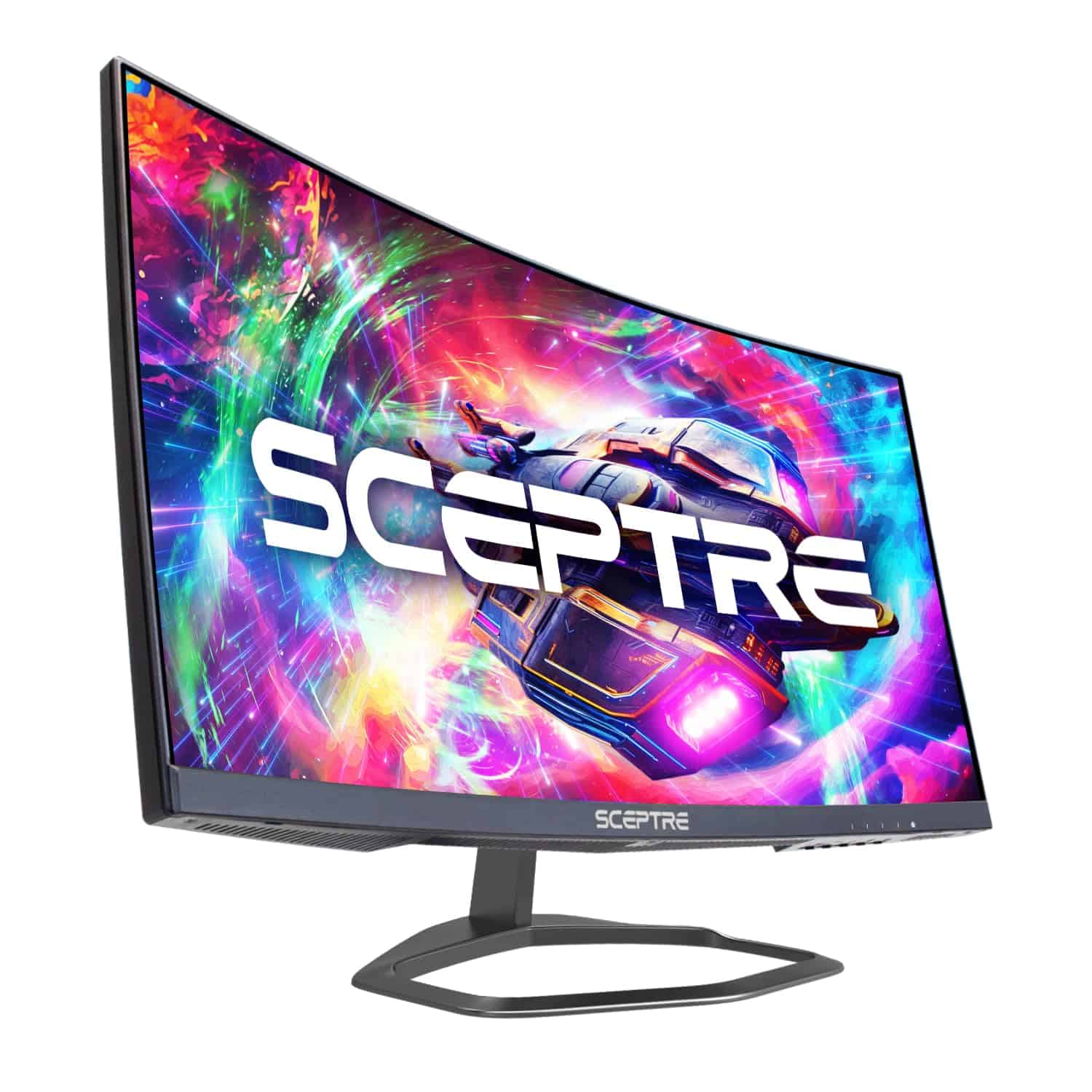
The Sceptre 24.5″ Curved Gaming Monitor delivers impressive performance with its 240Hz refresh rate and 1ms response time at a reasonable price point that makes it an excellent choice for competitive gamers.
Pros
- Lightning-fast 240Hz refresh rate eliminates motion blur
- Comfortable 1500R curvature enhances immersion
- Multiple connectivity options with dual HDMI and DisplayPort
Cons
- Built-in speakers have mediocre sound quality
- Basic stand with limited adjustment options
- 1080p resolution may not satisfy users wanting higher pixel density
We recently tested the Sceptre 24.5″ Curved Gaming Monitor and found it hits a sweet spot for competitive gaming. The 240Hz refresh rate makes a noticeable difference in fast-paced games like first-person shooters. Everything feels smoother and more responsive compared to standard 60Hz or even 144Hz displays.
The 1500R curved screen pulled us into the gaming experience more than we expected from a 24.5″ display. It creates a more natural viewing angle that reduced eye strain during our longer gaming sessions. AMD FreeSync Premium technology eliminated screen tearing completely, which was a welcome feature during graphically intense gameplay.
For connectivity, we appreciated having two DisplayPorts and two HDMI ports. This flexibility let us connect multiple devices without constantly swapping cables. While the built-in speakers work in a pinch, they lack bass and volume for serious gaming. The matte screen finish effectively prevented glare and reflections, even when playing in brightly lit rooms. At this price point, the value is exceptional for anyone wanting to step up their gaming performance without breaking the bank.
Samsung Odyssey G55C 32″ Curved Gaming Monitor
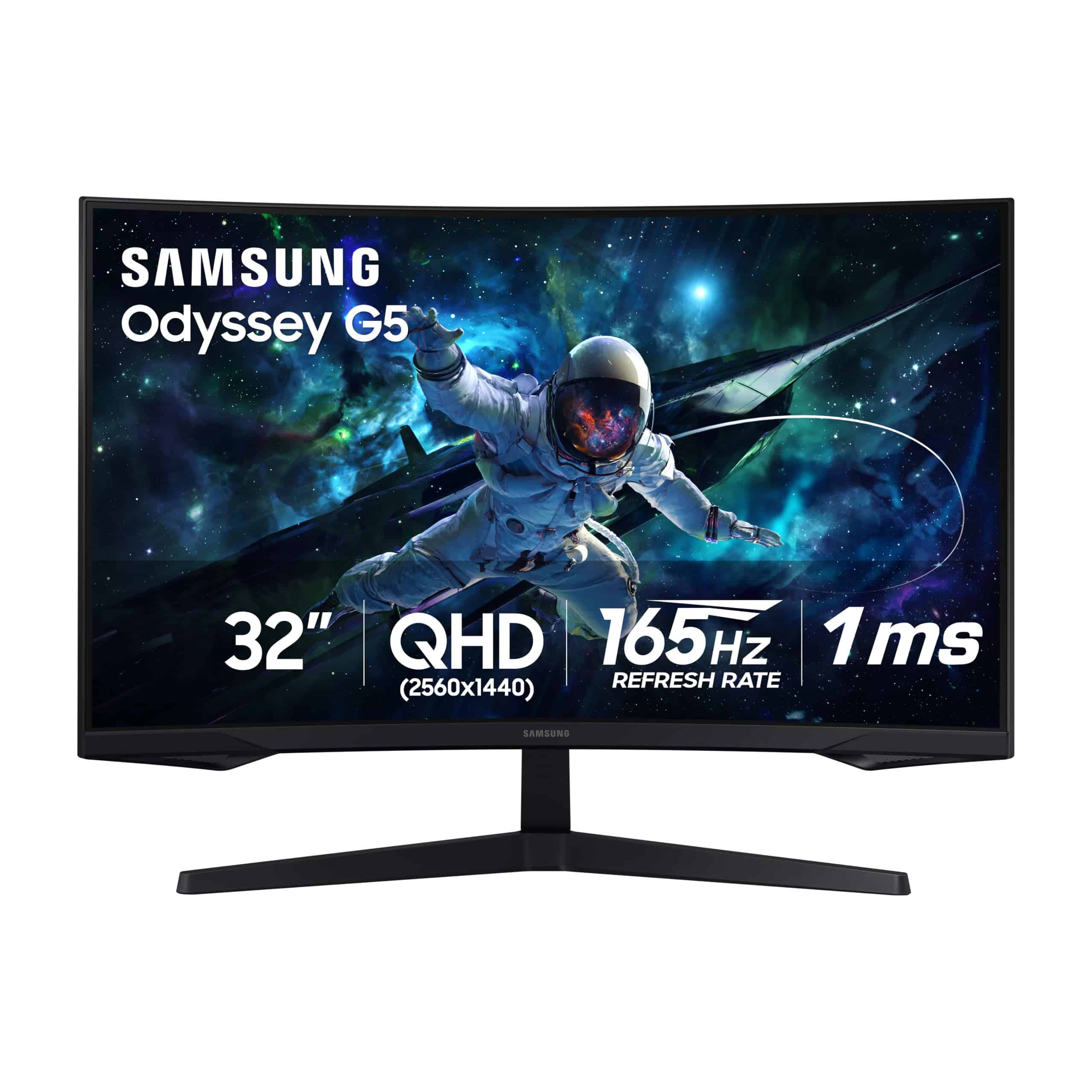
The Samsung Odyssey G55C offers an ideal balance of immersive gaming features and sharp visuals that make it a top choice for serious gamers looking for a large-format display.
Pros
- Immersive 1000R curved screen fills peripheral vision
- Smooth 165Hz refresh rate with 1ms response time
- Crisp QHD resolution with HDR10 support
Cons
- Text clarity might need adjustment in settings
- Large size requires decent desk space
- Some users report occasional flickering issues
We recently tested the Samsung Odyssey G55C and were immediately struck by its impressive curved design. The 1000R curvature isn’t just for show – it actually wraps around your field of view in a way that made our gaming sessions feel more immersive. Games like racing titles and first-person shooters benefit the most from this design.
The 32-inch screen size hits a sweet spot for gaming. It’s large enough to provide an engrossing experience without being overwhelming on a typical desk. The QHD (2560×1440) resolution is perfect for this size, offering much sharper images than 1080p monitors without requiring the powerful GPU you’d need for 4K gaming.
During fast-paced action games, we noticed virtually no motion blur thanks to the 165Hz refresh rate and 1ms response time. AMD FreeSync technology eliminated screen tearing completely, making games look buttery smooth. The HDR10 support adds nice depth to shadows and highlights, though it’s not as dramatic as higher-end HDR implementations.
Eye comfort is another area where this monitor shines. After several extended gaming sessions, we experienced less eye fatigue than expected. The Eye Saver Mode reduces blue light, which is helpful for those late-night gaming marathons. The screen’s anti-glare coating works well in bright rooms too.
Setting up the monitor was straightforward, though we did need to adjust the sharpness settings to improve text clarity. For productivity tasks like spreadsheets and coding, the large screen provides plenty of workspace. The curved design took a day or two to get used to for office work, but it quickly became natural.
Sceptre 30-inch Curved Gaming Monitor
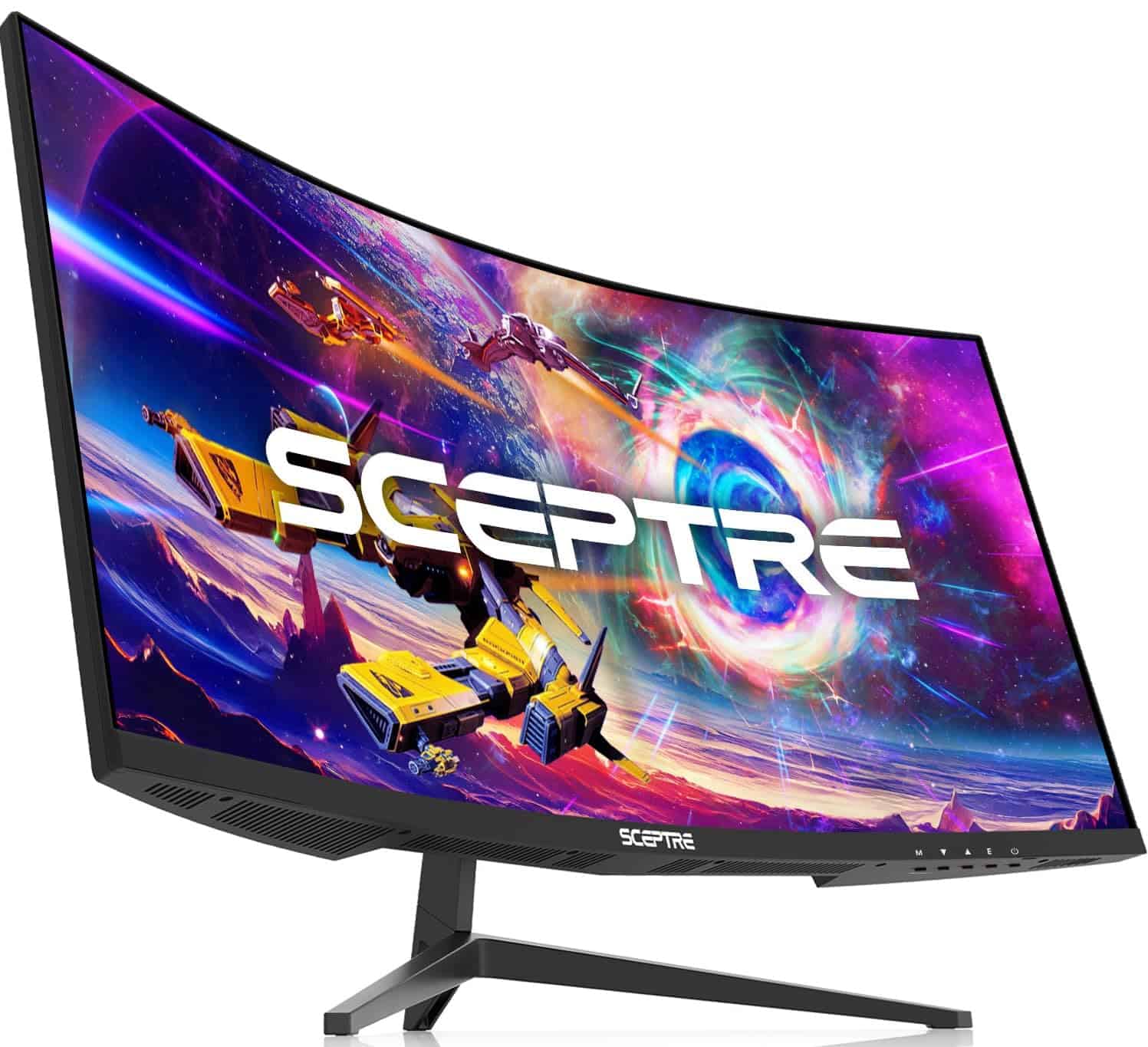
We believe the Sceptre 30-inch Curved Gaming Monitor offers exceptional value for gamers who want an immersive ultrawide experience without breaking the bank.
Pros
- Smooth 200Hz refresh rate eliminates motion blur
- Ultrawide 21:9 aspect ratio enhances gaming immersion
- Built-in eye protection with Blue Light Shift technology
Cons
- 1080p resolution might feel low for some content
- Speakers provide basic sound quality at best
- Curved design takes up more desk space
The Sceptre C305B-200UN1 delivers an impressive gaming experience right out of the box. We noticed immediately how the 30-inch curved display wraps around our field of vision, making games feel more immersive. The ultrawide 21:9 aspect ratio gives extra screen real estate that’s perfect for racing games and strategy titles.
During our testing, the 200Hz refresh rate made a noticeable difference in fast-paced games. Everything looked butter-smooth with virtually no motion blur. AMD FreeSync technology eliminated screen tearing completely, which is crucial when playing competitive shooters. The 2560×1080 resolution looks sharp enough for most gaming, though text can appear slightly less crisp for productivity work.
Setting up the monitor was straightforward with multiple connection options. We appreciated the slim bezels that create a more premium look than the price suggests. The built-in Blue Light Shift feature helped reduce eye strain during our longer gaming sessions. While the integrated speakers won’t replace a dedicated audio setup, they’re good enough for casual use. For gamers wanting to upgrade from a standard display without spending premium prices, this Sceptre monitor hits the sweet spot of performance and value.
Samsung Odyssey G3 27-Inch Gaming Monitor
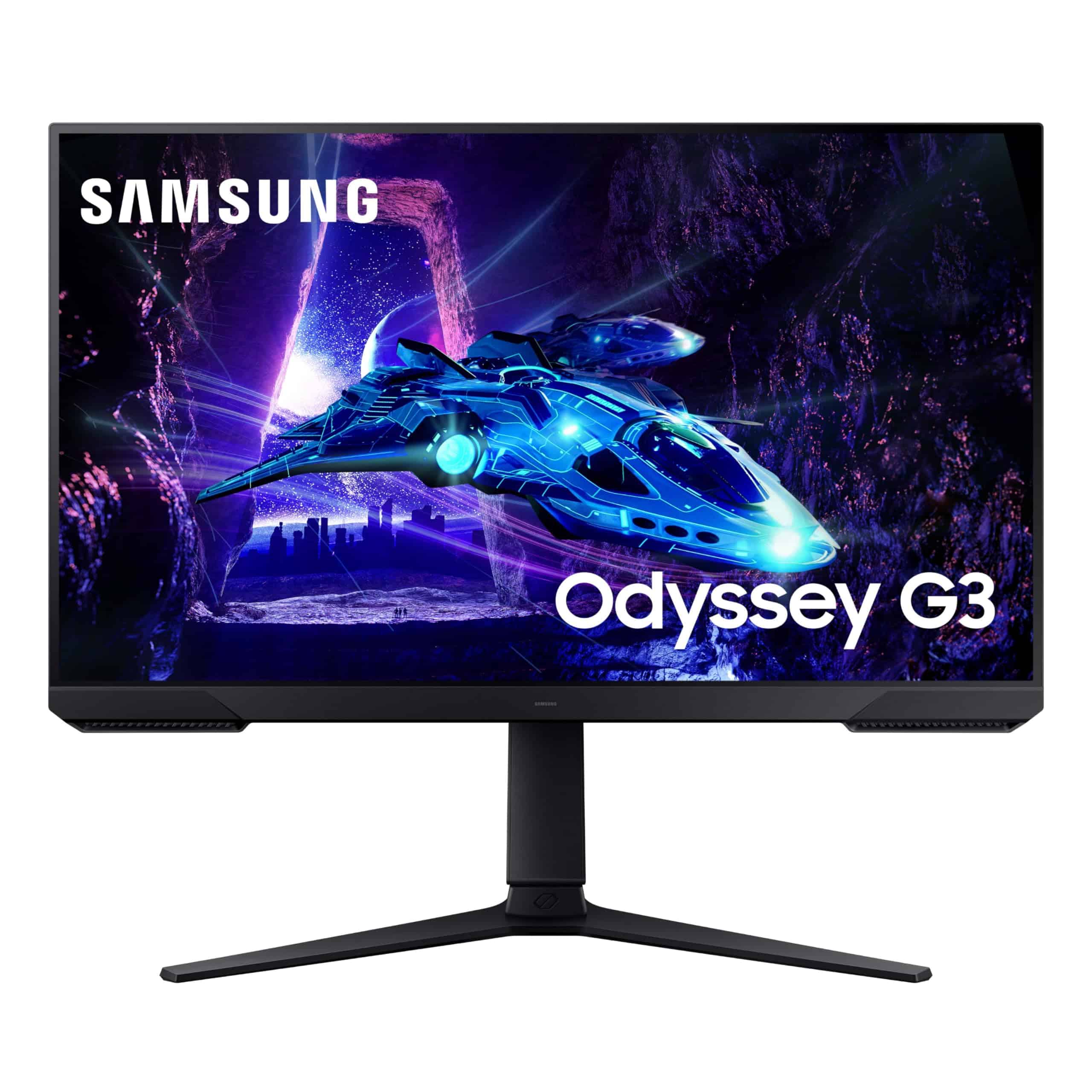
The Samsung Odyssey G3 offers the perfect balance of speed, screen size, and features for most gamers looking for a competitive edge without breaking the bank.
Pros
- Lightning-fast 180Hz refresh rate with 1ms response time
- Highly adjustable stand for ergonomic comfort
- AMD FreeSync prevents screen tearing
Cons
- Limited to 1080p resolution
- No built-in speakers
- Black levels could be deeper in some lighting conditions
We recently tested the Samsung Odyssey G3, and it hits the sweet spot for competitive gaming at 27 inches. The FHD display gives you enough screen real estate without demanding too much from your graphics card. This size works perfectly for most desk setups, and we found ourselves able to see the entire screen without having to move our heads.
The 180Hz refresh rate makes a noticeable difference in fast-paced games. During our testing with first-person shooters, the smooth motion tracking gave us a clear advantage in spotting enemies quickly. The 1ms response time eliminated motion blur that we often see on slower monitors. The Black Equalizer feature helped us spot enemies hiding in dark corners – something that gave us a real competitive edge.
Setting up the monitor was straightforward, and we appreciate the flexibility of the stand. It allowed us to adjust the height, tilt, and even rotate to portrait mode. After gaming for several hours, the Eye Saver Mode kept our eyes from feeling strained. The three-sided borderless design also looks clean on our desk and would work great in a dual-monitor setup. For competitive gamers who value speed over resolution, this 27-inch display hits the mark perfectly.
Sceptre 27″ Gaming Monitor
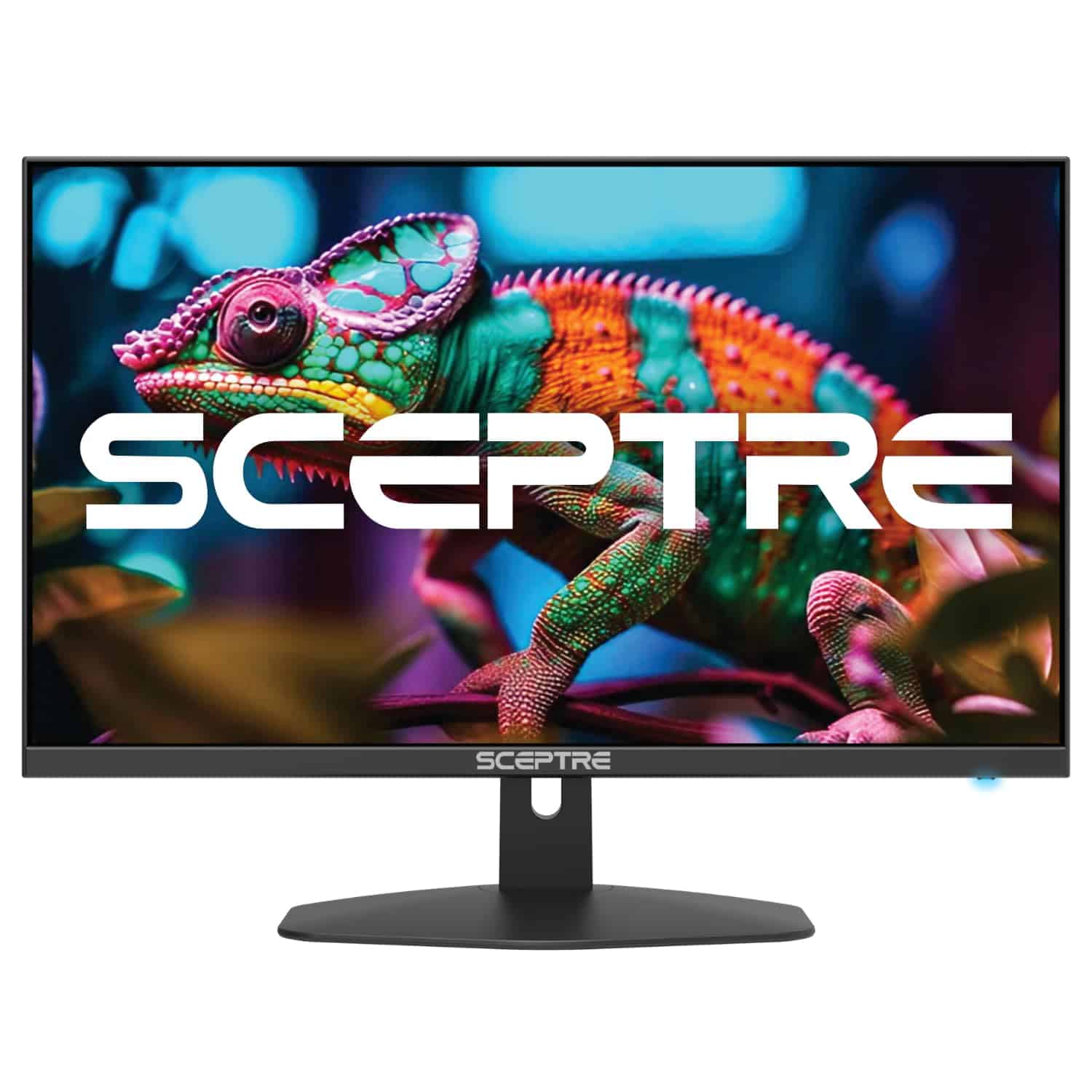
The Sceptre 27″ gaming monitor offers excellent value with its 100Hz refresh rate, FreeSync support, and vibrant display that works well for both gaming and everyday use.
Pros
- Crisp 1080p display with 100% sRGB color coverage
- Multiple connectivity options (2 HDMI, 1 DisplayPort)
- Blue Light Shift feature reduces eye strain
Cons
- Button placement and controls can be frustrating
- Built-in speakers provide basic sound quality
- Stand has limited adjustment options
We recently tested this 27-inch Sceptre gaming monitor and found it hits a sweet spot for gamers who want performance without breaking the bank. The 100Hz refresh rate provides smooth gameplay, while the 1ms response time keeps fast-paced action free from noticeable blur. Colors pop thanks to the 100% sRGB color gamut, making games look vibrant and lifelike.
Setup was quick and straightforward. The monitor features a sleek, frameless design that looks modern on any desk. At just over 7 pounds, it’s surprisingly lightweight, which made positioning easy. The VESA mount compatibility also gives flexibility if you prefer mounting it on a wall or monitor arm.
Gaming performance impressed us during testing. AMD FreeSync technology prevented screen tearing in fast-paced games, while the dedicated FPS and RTS game modes optimized the display for different gaming styles. The Blue Light Shift feature was a welcome addition during longer gaming sessions, reducing eye fatigue noticeably. Connectivity options are generous, with two HDMI ports and one DisplayPort handling multiple devices easily.
For everyday use, the monitor performs equally well. Text appears sharp, videos look great, and the 27-inch size provides ample screen space without overwhelming a typical desk. While the built-in speakers won’t replace a dedicated audio setup, they’re adequate for casual use when you don’t want to wear headphones.
The main drawbacks we found were the somewhat awkward button placement and limited stand adjustability. The on-screen menu system takes some getting used to. Despite these minor issues, the Sceptre 27″ gaming monitor delivers excellent performance for its price point, making it a solid choice for gamers and general users alike.
Sceptre 27″ Curved Gaming Monitor
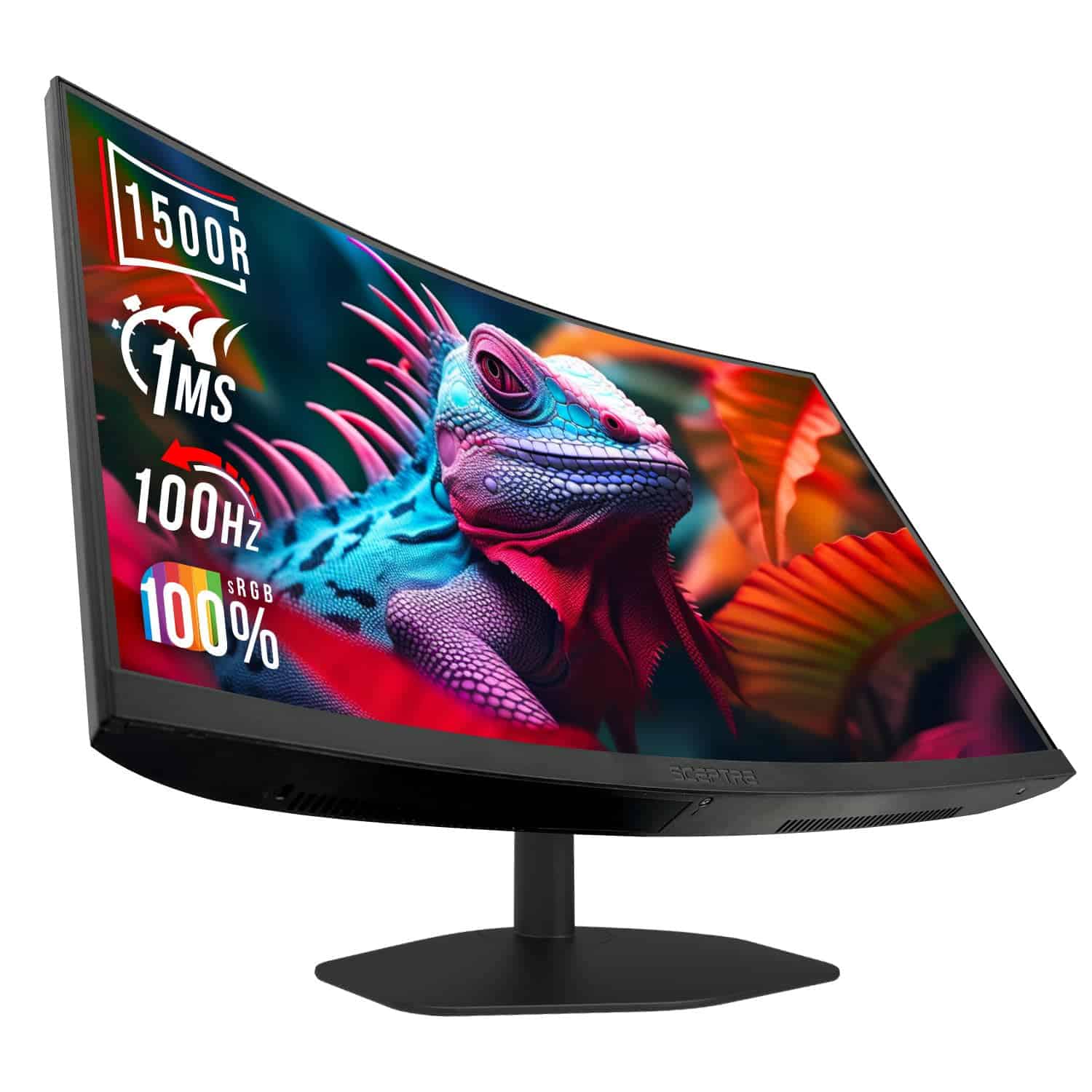
The Sceptre C275W-FW100T offers an ideal balance of gaming performance and productivity features at a budget-friendly price that makes it a smart purchase for most gamers.
Pros
- Smooth 100Hz refresh rate with 1ms response time
- Eye-friendly features including Blue-Light Shift technology
- Versatile connectivity with dual HDMI ports and DisplayPort
Cons
- Built-in speakers lack audio quality
- 1080p resolution might seem low for some users
- Limited adjustment options for height and tilt
We recently spent time testing the Sceptre 27″ curved gaming monitor, and it impressed us with its immersive 1500R curvature. The gentle curve wrapped around our field of vision, making both work tasks and gaming sessions feel more natural. During intense gaming, we noticed the curve helped us stay focused on the action.
The monitor’s 100Hz refresh rate made a big difference in gameplay smoothness. Fast-moving objects stayed clear and sharp, which gave us an edge in competitive games. We especially appreciated the 1ms response time when playing first-person shooters where quick reactions matter most.
Colors on this display look vibrant thanks to its 100% sRGB coverage. We found this helpful when editing photos and videos, not just for gaming. The matte screen finish also did a good job preventing glare during daytime use. After several hours of use, the Blue-Light Shift feature noticeably reduced eye strain compared to our previous monitor.
Connecting our devices was simple with the two HDMI ports and DisplayPort input. We could keep multiple systems hooked up without constantly swapping cables. While the built-in speakers work for basic needs, we recommend external speakers or headphones for better sound quality during gaming sessions.
AOC C27G2Z Curved Gaming Monitor
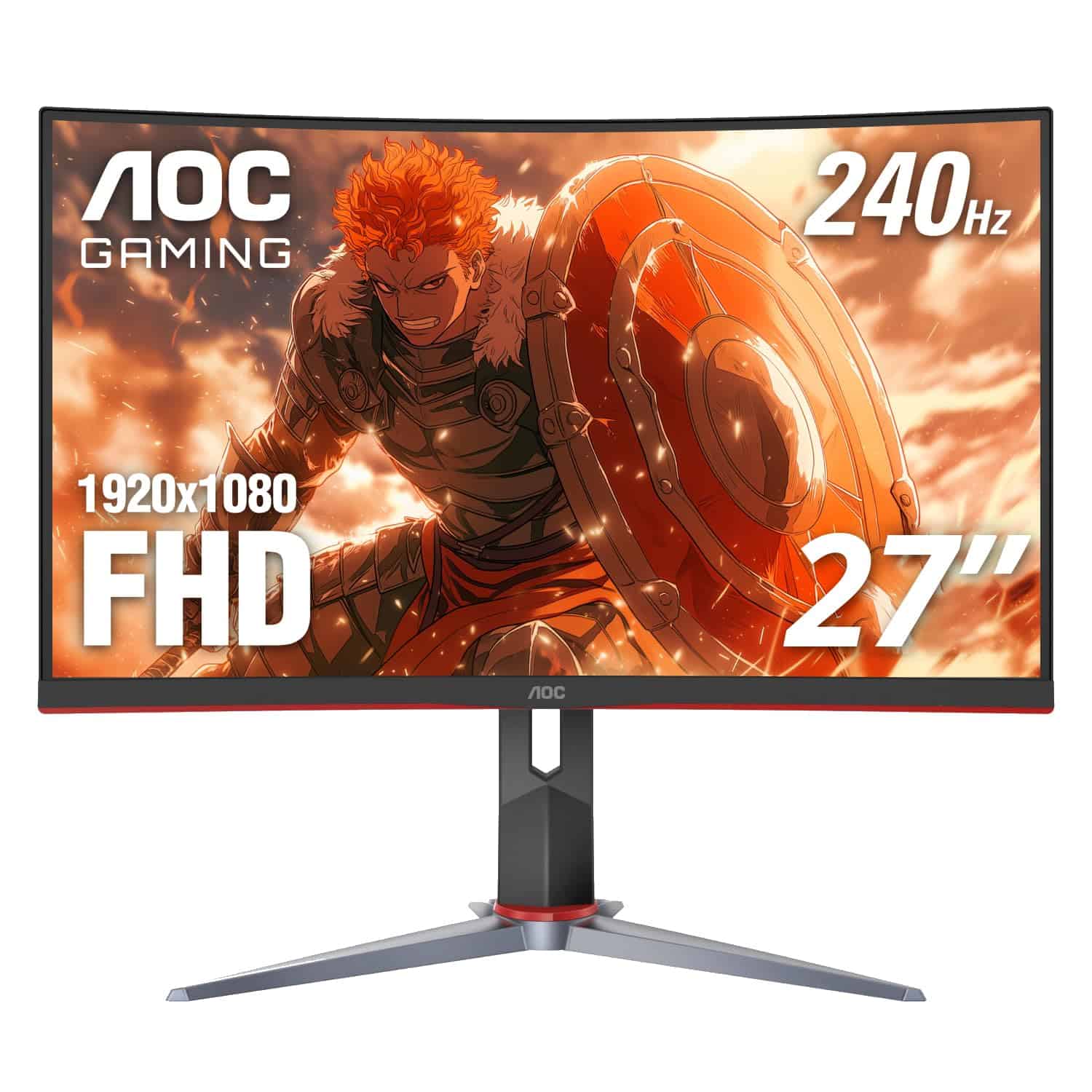
The AOC C27G2Z offers an ideal balance of speed, immersion, and value that makes it a top choice for competitive gamers who need lightning-fast response times.
Pros
- Incredibly fast 0.5ms response time and 240Hz refresh rate
- 1500R curved screen creates better immersion
- Height-adjustable stand for comfortable long gaming sessions
Cons
- 1080p resolution may feel limited on a 27-inch screen
- VA panel has some viewing angle limitations
- Might be overkill for casual gamers
We recently tested the AOC C27G2Z and were blown away by its performance in fast-paced games. The 240Hz refresh rate combined with the 0.5ms response time creates buttery-smooth gameplay that gives a real competitive edge. When playing first-person shooters, we noticed significantly less motion blur compared to standard 144Hz monitors.
The 1500R curve wraps nicely around your field of vision and pulls you into the game world. This design isn’t just for show – it actually reduces eye strain during longer gaming sessions by keeping the entire screen at a more consistent viewing distance. The 27-inch size hits a sweet spot for desktop gaming, though we did notice the 1080p resolution isn’t quite as sharp as we’d like when doing detailed work outside of gaming.
Setting up the monitor was straightforward with its height-adjustable stand. We appreciate that AOC included both HDMI and DisplayPort cables in the box. The 3-sided frameless design looks sleek on any desk and works great for multi-monitor setups. AMD FreeSync Premium technology eliminated screen tearing completely in our tests, though this feature obviously benefits AMD GPU users most. For its price point, we found the AOC C27G2Z delivers exceptional speed and performance for competitive gamers.
SANSUI 34-Inch Curved Gaming Monitor
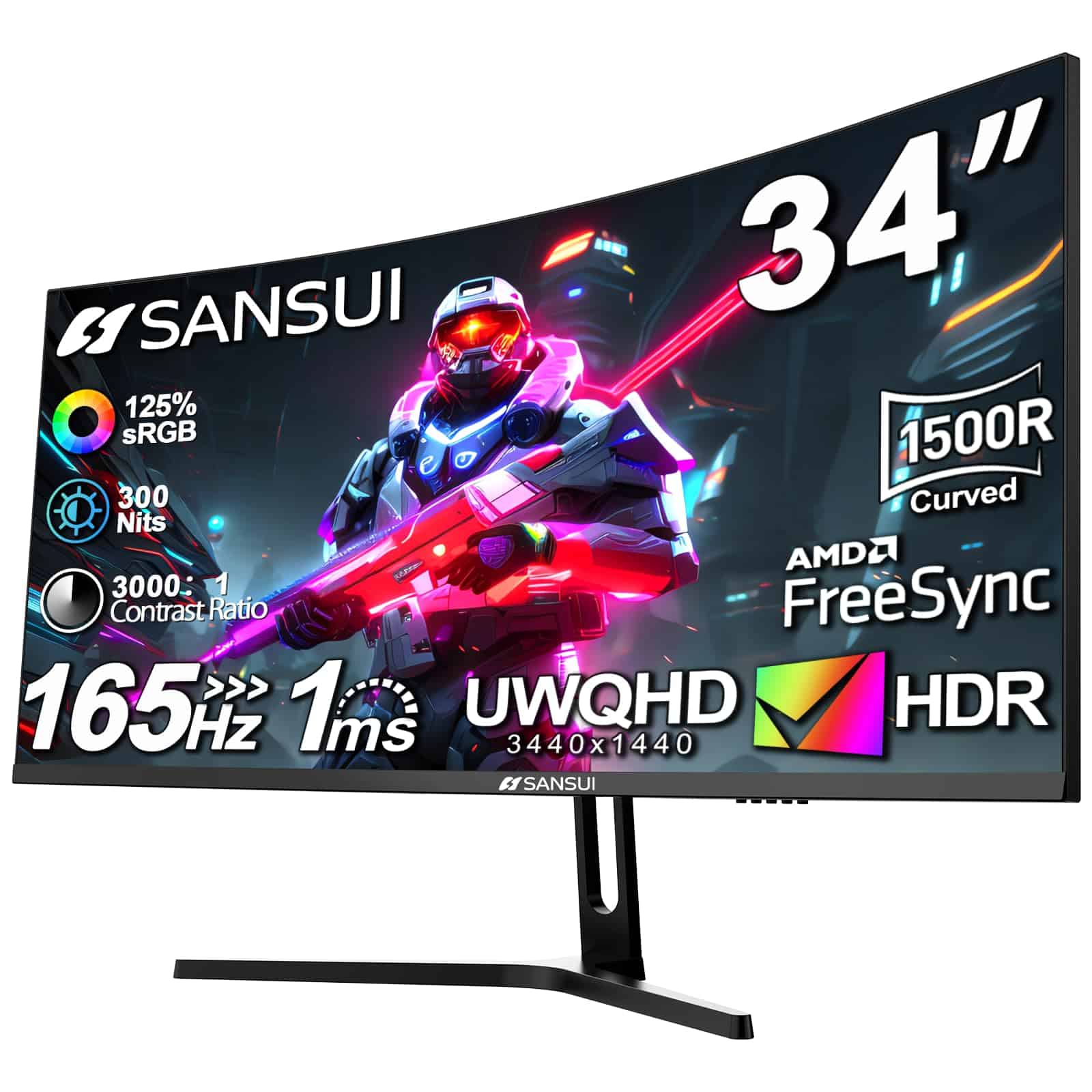
This ultrawide curved gaming monitor delivers excellent immersion and performance for both casual and competitive gamers at a reasonable price point.
Pros
- Immersive 1500R curved design with ultrawide 21:9 aspect ratio
- Smooth 165Hz refresh rate with 1ms response time
- Rich color reproduction with 125% sRGB and 95% DCI-P3
Cons
- Stand has limited adjustability options
- No built-in speakers
- Brightness could be better for some HDR content
We recently tested the SANSUI 34-inch curved gaming monitor and were impressed by the immersive experience it delivers. The 1500R curvature wraps around your field of vision, making games feel more engaging. When playing racing games, we could see more of the track at once, giving us a competitive edge.
The 3440 x 1440 resolution strikes a good balance between sharpness and performance. Text looks crisp for productivity work, while games show plenty of detail without requiring a top-tier GPU. The 165Hz refresh rate made a noticeable difference in fast-paced games, with smooth motion that helped us track enemies more easily.
Color quality exceeded our expectations for this price range. The 125% sRGB coverage means vibrant colors pop in games and videos. During our testing, dark scenes showed good detail thanks to the VA panel’s contrast, though we noticed some minor ghosting in extremely fast-moving scenes. The monitor’s ports (two HDMI and two DisplayPort) gave us plenty of flexibility for connecting multiple devices.
Setup was straightforward with the included DisplayPort cable, though we wish the stand offered height adjustment in addition to tilt. For anyone wanting an affordable entry into ultrawide curved gaming, this monitor delivers impressive performance without breaking the bank.
KTC 32″ Curved Gaming Monitor
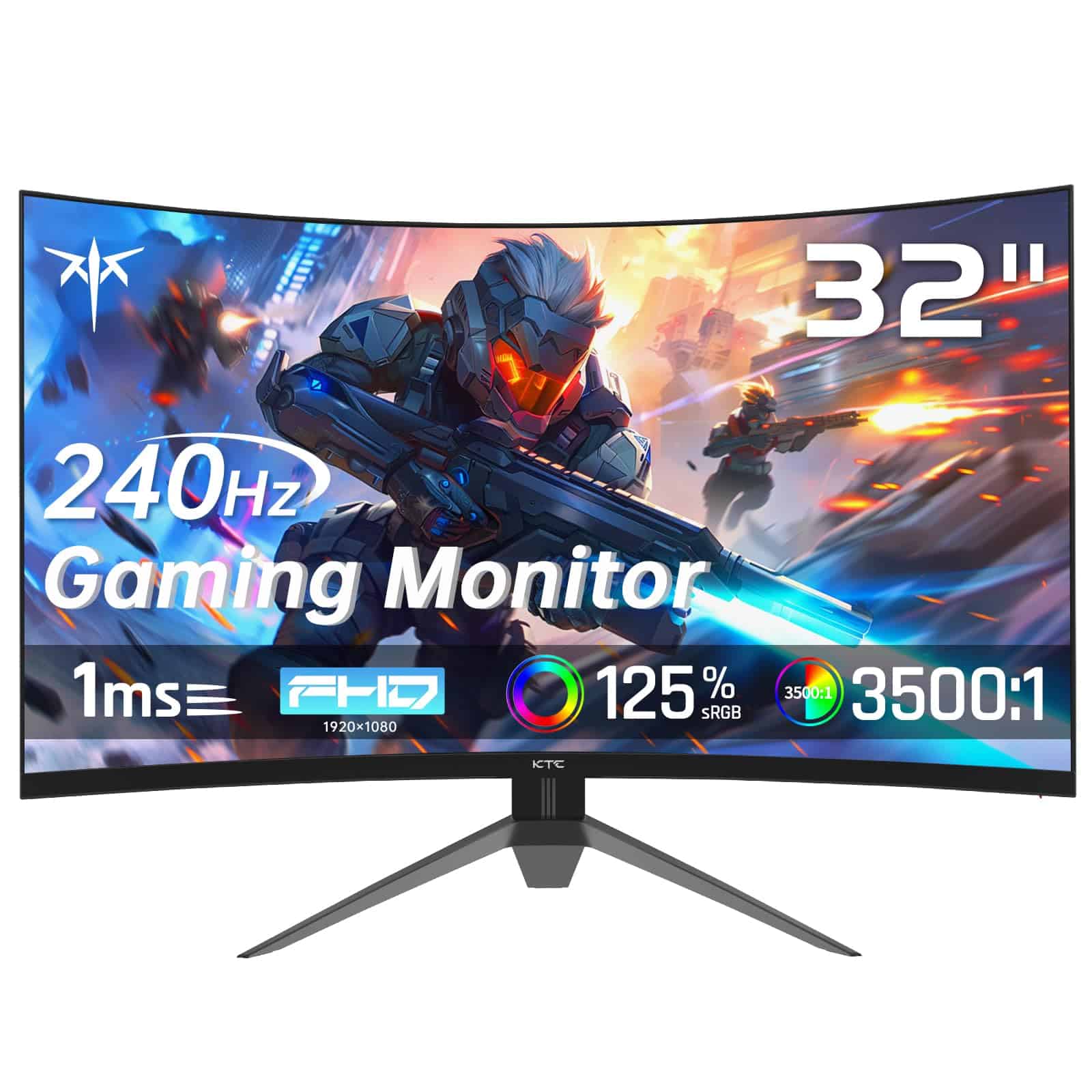
The KTC 32-inch curved gaming monitor delivers exceptional value with its 240Hz refresh rate and immersive 1500R curve, making it a solid choice for competitive gamers who want speed without breaking the bank.
Pros
- Ultra-smooth 240Hz refresh rate eliminates motion blur
- Immersive 1500R curved design enhances gaming experience
- Excellent connectivity options with dual HDMI 2.0 ports
Cons
- 1080p resolution might seem low for a 32-inch screen
- Stand has limited adjustment options
- Build quality feels slightly less premium than higher-end models
We recently tested this KTC gaming monitor and were impressed by its performance for fast-paced games. The 240Hz refresh rate makes a noticeable difference in competitive titles like Counter-Strike and Valorant. Images flow smoothly across the screen with minimal ghosting, giving us a real competitive edge.
The 1500R curved design pulled us into our games more than we expected. While using it for several hours, we found the curve reduced eye strain compared to flat panels of similar size. The 178° viewing angle means colors stay consistent even when viewing from the sides, which is helpful during multiplayer sessions.
Color reproduction exceeded our expectations for a gaming-focused monitor. With 125% sRGB coverage and HDR support, games look vibrant and punchy. The 3500:1 contrast ratio creates deep blacks that make dark scenes in games like Diablo IV more atmospheric. We appreciated the anti-glare coating that minimized reflections from nearby windows during daytime gaming sessions.
Connectivity is another strong point. With two HDMI 2.0 ports and DisplayPort 1.4, we easily connected multiple devices without constantly swapping cables. The tilt adjustment range (-5° to 15°) could be more generous, but the VESA mount compatibility provides flexibility if you need more positioning options.
Buying Guide
Choosing the right gaming monitor size can be tricky. We’ve created this guide to help you make the best choice for your gaming needs.
Resolution vs. Screen Size
The monitor’s resolution should match its size. Larger screens need higher resolutions to maintain image clarity.
| Screen Size | Recommended Resolution |
|---|---|
| 24-25 inch | 1080p (Full HD) |
| 27-32 inch | 1440p (QHD) |
| 32+ inch | 4K (UHD) |
A mismatch between size and resolution can lead to pixelated images or wasted potential.
Consider Your Setup
Measure your desk space before buying. A massive monitor won’t be enjoyable if you’re sitting too close to it.
For most desks, monitors between 24-32 inches work best. If you sit about arm’s length from your screen, a 27-inch monitor often provides the ideal balance.
Panel Type Matters
Different panel technologies offer unique benefits for gamers.
- IPS: Best color accuracy and viewing angles
- VA: Best contrast ratios and deep blacks
- TN: Fastest response times but weaker colors
Refresh Rate and Response Time
For competitive gaming, look for:
- Refresh rates of 144Hz or higher
- Response times under 5ms (1ms is ideal)
For casual gaming or story-based games, 60-75Hz may be sufficient.
Connectivity Options
Ensure your monitor has the right ports for your setup:
- HDMI 2.0 or 2.1 for console gaming
- DisplayPort for high refresh rate PC gaming
- USB ports for peripherals
Budget affects your options, but we recommend not skimping on features you’ll use daily.
Frequently Asked Questions
Monitor size plays a crucial role in gaming performance, comfort, and overall experience. Here are answers to common questions about choosing the right gaming monitor size.
What is the optimal screen size for a 4K gaming experience?
For 4K gaming, 27 to 32 inches is generally ideal. At this size, you can fully appreciate the extra detail of 4K resolution without needing to scale the interface.
Smaller screens make 4K details harder to notice, while larger screens might require you to sit farther back for comfortable viewing. A 32-inch monitor offers an excellent balance for 4K gaming.
How does monitor size impact competitive gaming performance?
Smaller monitors (24-27 inches) often benefit competitive gamers because they allow you to see everything without moving your eyes much. This helps with reaction time and focus.
Many pro gamers use 24-inch monitors because they can keep all important game information within their immediate field of view. Larger screens might force you to move your head or miss details at the edges.
What are the benefits of a 27-inch gaming monitor over other sizes?
The 27-inch size hits a sweet spot for most gamers. It provides enough screen space without overwhelming your desk or peripheral vision.
This size works well with 1440p resolution, offering sharp images without requiring a top-tier graphics card. 27-inch monitors are also widely available at various price points with gaming-focused features.
Which monitor dimensions are preferred for both gaming and office tasks?
A 27 to 32-inch monitor usually works best for both gaming and productivity. This size range provides enough space for spreadsheets and multiple windows while still being excellent for gaming.
Ultrawide monitors (34-38 inches) are gaining popularity for dual-purpose use. They offer extra horizontal space for work while providing an immersive gaming experience without the bezels of a multi-monitor setup.
What are professional recommendations for monitor size when using a 1440p resolution for gaming?
For 1440p gaming, most professionals recommend 27 inches as the ideal size. At this size, 1440p provides a sharp image with a pixel density of about 109 PPI (pixels per inch).
Larger monitors (32 inches) with 1440p resolution start to show individual pixels more clearly, reducing image sharpness. Smaller screens with 1440p may waste the resolution’s potential as details become too small to appreciate.
How do I choose the best gaming monitor size to meet my needs?
Consider your desk space first. Measure how far you typically sit from your monitor and choose a size that fits that distance.
Think about the games you play most. Competitive FPS players often prefer 24-27 inches, while strategy and RPG gamers might enjoy 27-32 inches for more detail.
Match your monitor size to your preferred resolution. For 1080p, stick with 24-27 inches; for 1440p, choose 27-32 inches; and for 4K, 27-32 inches works best.

